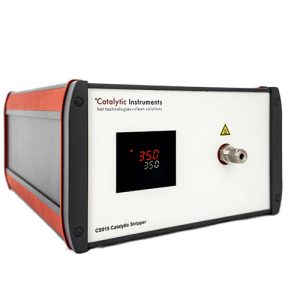Catalytic Strippers
Catalytic Strippers
Catalytic Strippers are heated catalytic elements that are used to remove the particle and gas-phase semi-volatile fraction of an aerosol. Diesel, locomotive, and gas turbine exhaust contains a complex mixture of solid particles and semi-volatile material that is found in both the particle and the vapor phase.
Physical and chemical characterization of these exhaust aerosols in the environment enables a better understanding of potential health effects, effectiveness of alternative combustion technologies and emission control devices, and the impact of new fuel and lubricant formulations on emissions. These measurements are enabled through the use of catalytic stripper (CS) technology.
Ambient Air Monitoring
Catalytic strippers can be used to determine the solid and semi-volatile particle concentrations in ambient air, in urban and rural environments. This can help in source apportionment – determining the source of emissions. Catalytic strippers can also be used at high altitude to determine the volatility characteristics of aircraft plumes. Measurement of solid and semi-volatile particle concentrations on-road and nearby roads can give an indication of particle aging due to growth by the uptake of semi-volatile material.
Engine Generated Solid Particle Measurement
Catalytic strippers can be used to determine the solid and semi-volatile particle concentrations in engine exhaust in the laboratory or during on-board vehicle measurements. Engines burning gasoline, diesel fuel, and natural gas all produce solid and semi-volatile particles. For oxygen rich combustion such as diesel, engine exhaust can be directly sampled by the catalytic stripper and measured by a suitable instrument.
However, for oxygen lean combustion such as gasoline, engine exhaust must be diluted prior to measurement so that the oxidation reaction can occur. The residence time in the catalytic stripper is low, so this device can be used in transient engine exhaust measurements. Another application is measuring emissions from gas turbines in laboratory and ambient environments.
Combustion Generated Solid Particle Measurements
Catalytic strippers can be used to determine the solid and semi-volatile particle concentrations in combustion aerosol sources. Some examples are biomass burning in the ambient environment or in laboratory evaluations of cooking stoves. Solid and semi-volatile particles are created by open flames such as candles. Most commercial soot generators do not produce completely “dry” soot so our catalytic strippers can be used to remove the majority of the organic carbon concentration.
Catalytic Vapor Filters
Feel free to click HERE to learn more about our range of catalytic vapor filters which may be used seperately or used along side catalytic vapor strippers.


